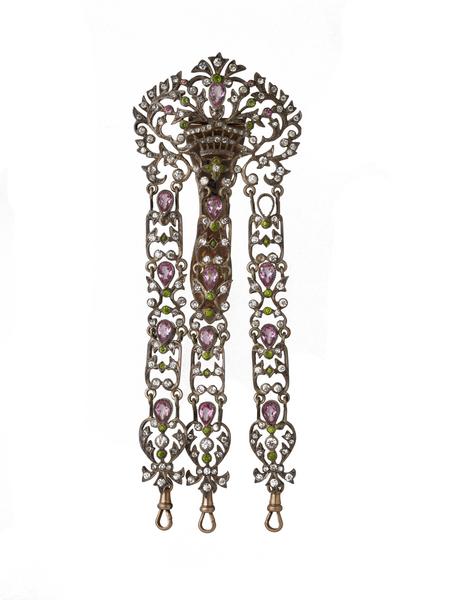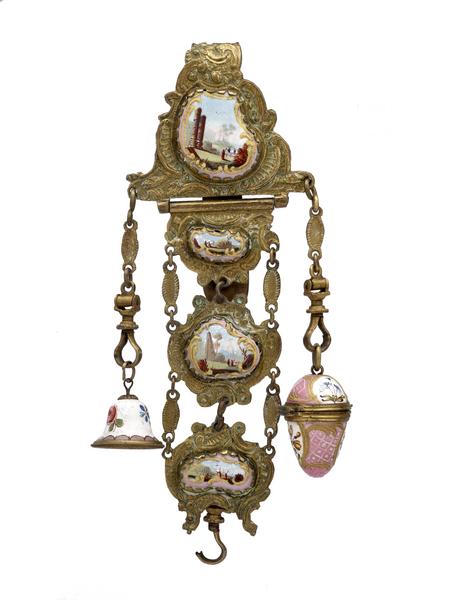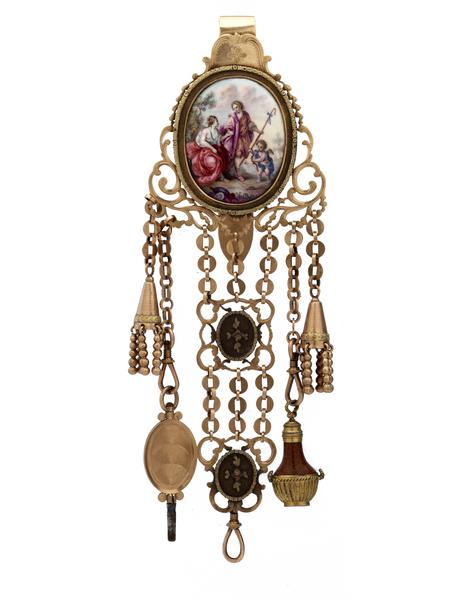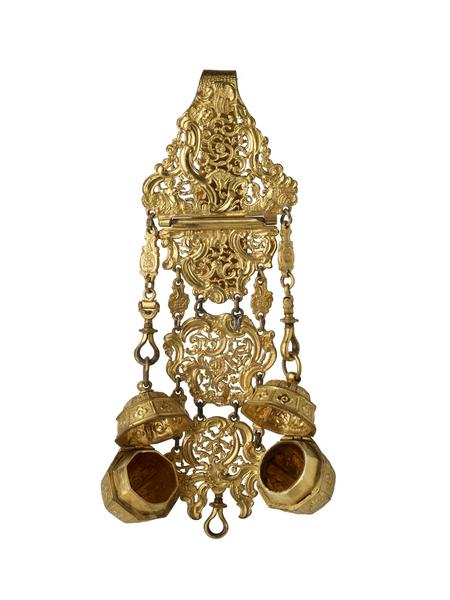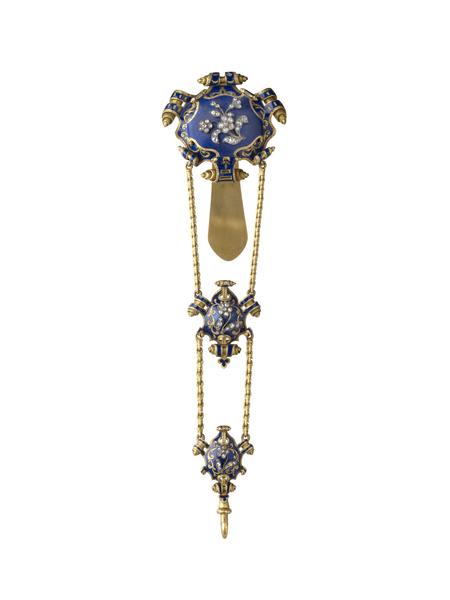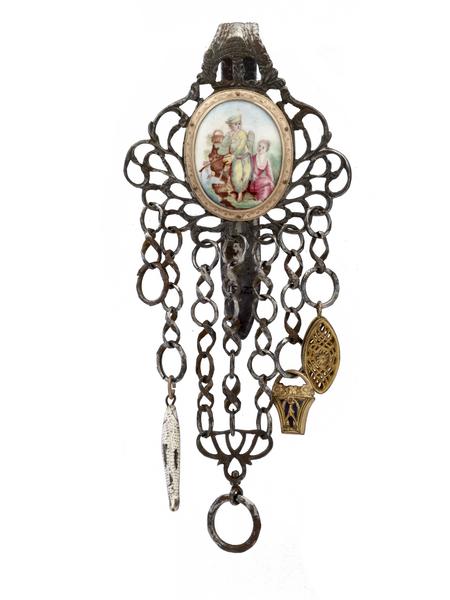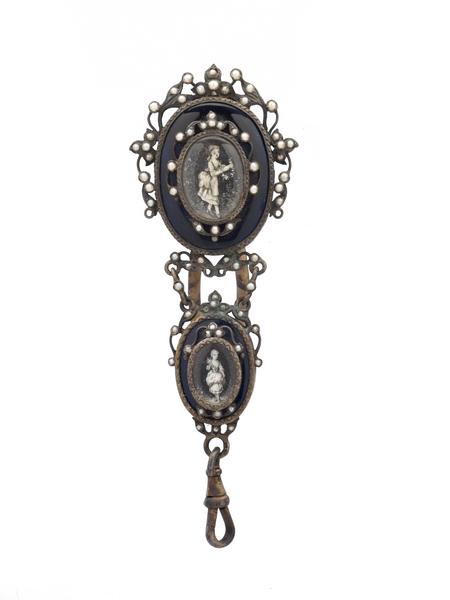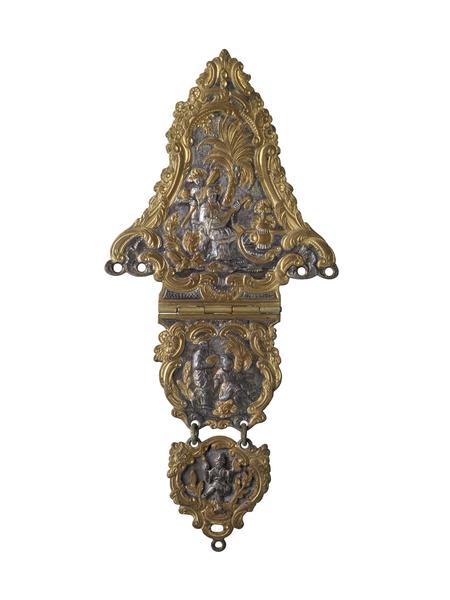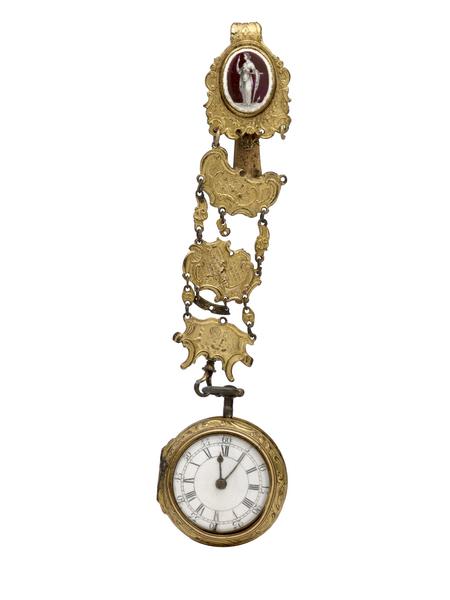22 April 2024 — By Beatrice Behlen
The queen’s chatelaine bag
From their origins as part of medieval ‘tool belts’ to their resurgence as a practical necessity during restrictive Victorian-era fashion, these chatelaine bags hold a captivating tale of style and royal provenance.

“Medieval practicality to Victorian fashion”
When Princess Marina, Queen Victoria's great-granddaughter-in-law, donated a trove of royal clothing and accessories to the museum in 1966, little did she know their captivating tale. Among the negligees, stockings and bonnets, three small bags caught the eye of the museum’s curators. These regal receptacles, fashioned from metal frames and fabric, were known as ‘chatelaine bags’ – an accessory with a history as rich and complex as the royal family itself.
So, what are chatelaine bags?
The term ‘chatelaine’ itself has a fascinating etymology. It is derived from a French word meaning ‘mistress of a grand country estate’. In the 19th century, the name was applied to a decorative hook attached to a belt, with a series of chains suspending useful household items like keys, scissors, or even a small purse. This ingenious method of carrying one’s tools was associated with the Middle Ages.
Depictions of 16th-century women from central Europe, such as the captivating portrait of Elsbeth Lochmann by Swiss artist Tobias Stimmer, provide a glimpse of how a woman running a household carried the tools required for her work. The museum holds a large number of metal frames for purses such as hers, where the pouch part has long worn off. An almost intact late medieval leather purse is a rare survivor.
In the 18th century, chatelaines remained fashionable accessories, though they were often referred to as ‘equipages’, meaning ‘equipment’. This made sense as these ornaments were predominantly decorative versions of a modern Swiss Army Knife that women attached to their belts or dresses. Tools included thimbles, needle cases, scissors and sometimes also watches.
The chatelaine’s resurgence
It was in the 1860s that the chatelaine bag alone, without the array of tools, experienced a remarkable resurgence in popularity. As reported in the April 1864 issue of The Queen, these “small chatelaine bags suspended at the left side, and made of the same material as the belt, [were] now considered indispensable, and have completely replaced the pockets formerly worn upon the front breadth”.
The practicality of the chatelaine bag was particularly appealing when the style and cut of women’s gowns did not include pockets, such as a Princess dress in the museum’s collection. At the time, the Godey’s Lady’s Book and Ladies’ American Magazine noted that the new dresses left little room for convenient pockets prompting the use of chatelaine bags “made of satin, and covered with a bouquet of flowers, now replace pockets; a small handkerchief is seen peeping out from the centre of the flowers, perfumed with the same scent.”

A photograph of Queen Victoria with her children, including Princess Louise holding an elaborate chatelaine-style bag. Photo by William Edward Kilburn.
Unravelling the royal provenance
But what of the three chatelaine bags donated by Princess Marina to the museum? These royal receptacles, with their metal frames and fabric or leather attachments, held intriguing stories waiting to be uncovered.
The plainest of the three bags, with a steel frame and a chain that suggests a nickel plating, was recorded as belonging to either Queen Victoria or her daughter, Princess Louise. Although this particular bag lacked the hook that would have allowed it to be attached to a belt, it seems the term ‘chatelaine bag’ was used for any small receptacles of pouch-like shape with a metal frame and chain. Interestingly, a photo from 1852 shows Princess Louise holding a more elaborate bag of that style.
The second bag, with a silver frame and black velvet pouch, bears the marks of a Jewish-owned company: Rosenthal, Jacob & Co. The initials JR and SJ stand for Julius Rosenthal and Samuel Jacob, who were business partners between May 1881 and September 1892. This provides a clue as to the approximate date of the frame, if not the bag itself.

A chatelaine bag, 1870–1910.
Entrepreneurial journeys of two immigrant silversmiths
Delving deeper into the histories of the two silversmiths, we uncovered a fascinating tale of migration, craftsmanship and entrepreneurial spirit. Julius Rosenthal, born Judah Loewe in London in 1846, was the son of Loewe Judah, a language teacher who had arrived from Hanover, Germany in 1837.
Samuel Jacob had moved to London from Falmouth (Cornwall), a town where a thriving Jewish community was established from the 1740s.
While the bag frame might be the only Rosenthal, Jacob and Co. product to make it into our (or any museum’s) collection, the company produced a variety of silver items, ranging from belt buckles and book covers to shoe horns, perfume flasks and, intriguingly, a silver chatelaine, similar to the 18th-century versions.
After the dissolution of the partnership, Samuel Jacob continued his silversmith business as ‘Jacob & Sons’ until his death in 1913. The company continued to be listed in 1916 as ‘fancy silversmiths’, presumable run by Samuel’s son. Rosenthal, had a more chequered career. He traded as Rosenthal & Co. until 1895, when he went bankrupt. In 1901, he was listed as ‘Silversmith Gold & own acc’t’, which indicates that he might have done some private work until he died in 1912.

A chatelaine bag (1881–1892), bearing the mark of Rosenthal, Jacob and Co. on the frame.
Decoding Queen Victoria’s chatelaine bag
The most elaborate of the three bags was also registered as Queen Victoria’s and this is supported by the initials ‘VR’ worked into its silver frame. Deciphering the additional hallmarks on the bag's interior – a number, a triangle, the letters ‘IIF’, and a ‘C’ – proved to be a captivating puzzle.
After some sleuthing, we found that IIF was the mark of Jan Jacob Fels, a silversmith who worked in Kampen, Netherlands (the triangle mark) between 1783 and 1812. The ‘C’ stands for 1810, and the 10 denotes the fineness of the silver. According to a 2014 Kamper Almanak article by Wielent Harms, these frames were part of Dutch regional costume, traditionally presented by a groom to his future wife. The hook on our bag shows Moses holding the tablets.
But what about the royal initials? Further examination revealed additional, yet unidentified hallmarks on the back of the hook, leading us to surmise that an enterprising jeweller had likely acquired the frame and remodelled it for the royal customer in the second half of the 19th century. Presumably, the black silk fabric was also added at that time. Sadly, so far no images of Queen Victoria with a chatelaine bag have surfaced. The bags might have been rarely used gifts.
Chatelaine bags continued to be used in the early 20th century, as documented in several of Christina Broom’s photographs, sometimes to compliment a medieval costume. Unsurprisingly, the bags were not en vogue following the war, when looking into the past, at least for a while, went out of fashion. They also did not suit the evolving new silhouette with its dropped waist. For a while at least, bags did not dangle, but were to be clutched.
Beatrice Behlen is Senior Curator, Fashion and Decorative Art at London Museum.



